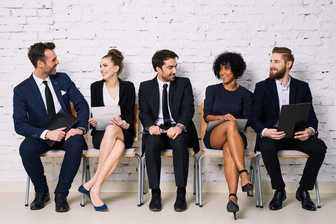 As more people travel around the globe with increasing regularity, making the right first impression begins at “Hello.” Note that greeting practices remain localized, rather than globalized (Tweet it!). Writing in The New York Times’ “What In the World” column far-flung journalist Andrew Jacobs offers some valuable tips:
We want to hear: What greeting customs have you noticed in your travels? Have they ever caught you by surprise? To join the conversation, click "comments" on our Community of Practice Forum. If you would like to read more about creating a habit around masterful communication, check out our book: Be Quiet, Be Heard: The Paradox of Persuasion.
4 Comments
 Based on decades of social science research, the book Give and Take by Professor Adam Grant, organizational psychology professor at the Wharton School of Business, divides the workplace world into three types of people—givers, matchers, and takers (Tweet it!). Givers give without expectation of immediate gain, sharing credit and mentoring generously. Matchers give when they think they will get something of equal value in return and give to people who they think can help them. Takers seek to come out ahead, managing up and defending their turf. Most people he surveyed fall into the matcher category — but givers, Grant says, “are overrepresented at both ends of the spectrum of success: they are the doormats who go nowhere or burn out, and they are the stars whose giving motivates them or distinguishes them as leaders.” The most successful givers, Grant explains, are those who rate high in concern for others but also in self-interest (Tweet it!). Strategic in their giving, they give to other givers and matchers, but are cautious about giving to takers for fear of being exploited. Successful givers give in ways that reinforce their social ties; and they consolidate their giving into chunks, so that the impact is intense enough to be gratifying. (Grant incorporates his field’s findings into his own life, meeting with students four and a half hours in one day rather than spreading meetings over the week because a study found that consolidating giving yields more happiness.) We want to hear: Do you consider yourself a “giver?” If so, what might you do to make your giving more successful? To join the conversation, click "comments" on our Community of Practice Forum. If you would like to read more about creating a habit around masterful communication, check out our book: Be Quiet, Be Heard: The Paradox of Persuasion.  Want to find an ideal team player? Patrick Lencioni, author of The Five Dysfunctions of a Team and The Ideal Team Player, suggests a three-trait cluster to be on the lookout for (Tweet it!) . In a Forbes interview he says a great team player is:
What makes humble, hungry, and smart people powerful and unique “is not the individual attributes themselves, but rather the required combination of the three,” Lencioni explained. Think of the best people on your team—do you consider them humble, hungry, and smart? How can you tell? To join the conversation, click "comments" below on our Community of Practice Forum. If you would like to read more about creating a habit around masterful communication, check out our book: Be Quiet, Be Heard: The Paradox of Persuasion  Psychology has provided much evidence that our partisan identities, such as whether we are Republicans or Democrats, distort our interpretations of reality (Tweet it!). But this selective perception phenomenon is not limited to the political arena. In one classic social psychology study researchers found that college football fans from Princeton and Dartmouth had strikingly different memories about the facts of a game between the two schools. When each school’s newspaper reported its own very different version of the game, researchers hypothesized that rival fans at the game saw it differently. As it turned out, Princeton students recalled the Dartmouth team had committed many more fouls, while Dartmouth students thought both teams were equally responsible. This is an example of how a partisan lens colors memory. Additional research by Jay Van Bavel, a professor of psychology at New York University, shows that our partisan biases can even color how we taste, see, hear, feel and smell (Tweet it!). We can’t help being partisan to some extent, but we can subject our selective perceptions to checks and balances by exposing ourselves to different worldviews, and by verifying what we think we know via fact-checking. We want to hear: Have you noticed that your view of reality diverges from that of others in your life? What trusted sources do you use to verify facts? To join the conversation, click "comments" on our Community of Practice Forum. If you would like to read more about creating a habit around masterful communication, check out our book: Be Quiet, Be Heard: The Paradox of Persuasion.  Haha! Observational studies show that 80 percent of laughter is less than fully genuine. Real laugher, which evolved since prehistoric times as a primal signal of safety, is bonding behavior -- and produces a mild euphoria as a result of released endorphins. So called “fake laugher” activates different neural pathways, and is often used strategically. Sometimes we “fake laugh” to ease social situations that may be stilted or uncomfortable (Tweet it!). According to a recent New York Times article, “We have probably all laughed on occasions when someone said something weird, vaguely insulting or just confusing. It’s an almost reflexive ruse so you can move through the awkward moment and perhaps allow the other person to save face.” “Your average person is pretty good at fake laughing in certain circumstances,” said Greg Bryant, a UCLA cognitive psychologist who studies laughter vocalization and interpretation. “It’s like when people say, ‘I’m not a good liar,’ but everyone is a good liar if they have to be.” Is laughing at inappropriate comments always the wisest thing to do? (Tweet it!) Jane Yates, a psychoanalyst who teaches at the Emory University Psychoanalytic Institute says maybe not, because it can encourage “the bad or clueless behavior that preceded it.” She recommends instead of laughing, filling the dead air following an unwanted or inept comment with something neutral like, “Well, then,” or, “Hmmm.” But that takes a good deal of self-awareness to pull off, she added, since many people are unconscious of their own forced levity. We want to hear: Do you ever notice yourself “fake laughing”? What are your motives for doing so? To join the conversation, click "comments" below on our Community of Practice Forum. If you would like to read more about creating a habit around masterful communication, check out our book: Be Quiet, Be Heard: The Paradox of Persuasion |
Archives
July 2024
Categories
All
|
|
Glaser & Associates, Inc.
Executive Offices 1740 Craigmont Avenue, Eugene, OR 97405 541-343-7575 | 800-980-0321 [email protected] |
© 2019 Glaser & Associates. All Rights Reserved.


 RSS Feed
RSS Feed